How can you tell a spiny euphorbia from a cactus? Evaluate these key characteristics: the type of spines, flowers, and leaves (or lack thereof).
Recently, while compiling my site's new Euphorbia page, I happily acquired the ability to tell at a glance a spiny euphorbia from a cactus.
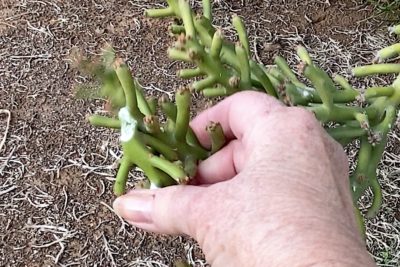
The defining characteristic of euphorbias is their milky sap.
Sure, you can break a stem, and if it drips milky sap, it's a euphorbia---whether poinsettia, spurge or a succulent tree. But hey! Now you don't have to.
Discover the differences here, then take the quiz on my YouTube channel. I promise you'll be delighted at your new knowledge!
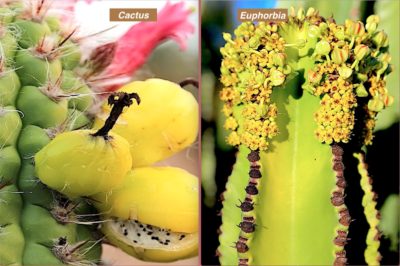
Cactus (left) shows spines, areoles, a pink flower and seed-filled fruit. At right, a euphorbia's flowers are tiny and yellow, and some have formed pods.
Euphorbia or Cactus? Check the flowers and fruit
Euphorbia blooms are tiny relative to the plant. They're most often yellow but may be pale green, cream, pink or red. What looks like petals are actually bracts that surround true flowers.
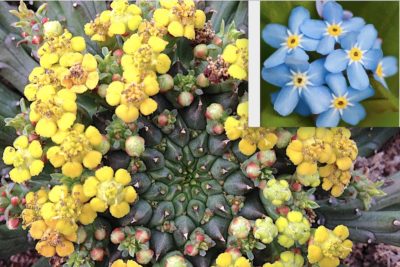
Euphorbia bracts look like yellow forget-me-nots
Bracts with five rounded petals resemble forget-me-nots, but are waxy and last longer.
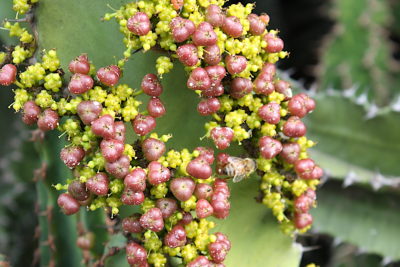
Euphorbia seed pods can be larger and more interesting than the flowers
They're followed by inedible, seed-filled fruit that's knobby, spherical or pumpkin-shaped.
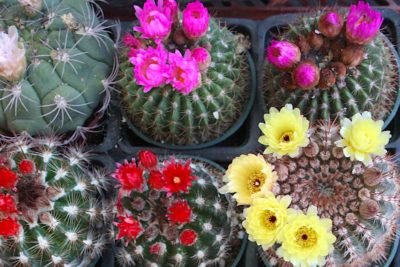
Many small cacti are crowned with vivid flowers in spring
Cactus flowers on the other hand tend to be showy, vividly colored and short-lived (a day or so). Delicate, satiny petals form flowers that look a bit like daisies or water lilies.
Fruit that follows cactus flowers is ovoid and in some species edible. Tiny black seeds dot the flesh.
Euphorbia or Cactus? Examine the spines
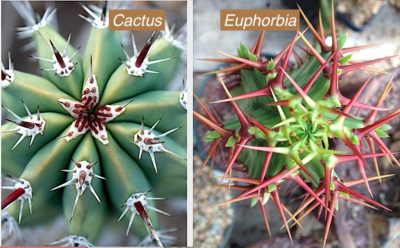
Areoles of cacti (left) are a different tissue from the skin, and spines appear to poke out through it.
A defining characteristic of cacti is that spines emerge from areoles (bumps or tissue) that are different from the skin of the plant. Cactus spines also tend to be needlelike. Although not all cacti have spines (visible ones at least), all cacti have areoles.
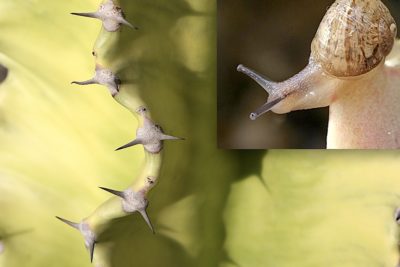
Euphorbia thorns make a V like a snail's head
Euphorbia spines are hard tissue like rose thorns, and often form a V suggestive of cattle horns or a snail's head. (Note: Many succulent euphorbias have no thorns.)
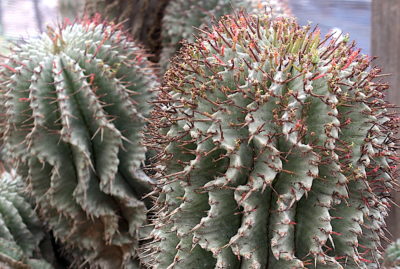
Dry flower stems (peduncles) cling to the ribs of Euphorbia horrida.
In some Euphorbia species, stems supporting bracts dry and cling to the plant. These "peduncles" may look like spines, but they are not sharp and snap off easily.
Euphorbia or Cactus? Look for leaves

Euphorbia trigona 'Rubra' (left) is fringed with lovely red leaves. Cholla at right has spines for leaves.
Surprisingly, spiny, cactuslike euphorbias produce leaves. If you don't see any, it's because in most species they tend to be insignificant, and they fall off seasonally.
Technically, cacti have "modified leaves:" spines. Stems of cacti may also look like leaves. However, cacti---unlike euphorbias---lack leafy leaves.
Incidentally, cacti are native to the Americas, and succulent euphorbias are from the Old World, mainly Africa. Over the last few centuries, collectors have helped these plants naturalize in warm, dry climates worldwide. But if you’re watching a movie that takes place millennia ago, and Jesus or Alexander the Great strides past a cactus, someone in Hollywood didn’t do their homework.
Test Your Knowledge
Related info on this site
Succulent Euphorbias: Photos, IDs, Garden Uses, Cautions
Euphorbia Uses, Photos and Cautions Native primarily to South Africa, succulent euphorbias thrive outdoors in mild, arid maritime climates. They’re wonderfully sculptural and collectible, but do be careful when handling. About SUCCULENT EUPHORBIAS Euphorbia is a huge genus composed of plants with milky sap, including spurges and poinsettias. Those that are succulents range from marble-size spheres…
The post Euphorbia or Cactus? How to Tell appeared first on Debra Lee Baldwin. Copyright © Debra Lee Baldwin.
from Debra Lee Baldwin https://ift.tt/3bTaUmm
via IFTTT


No hay comentarios:
Publicar un comentario